Brainstorming
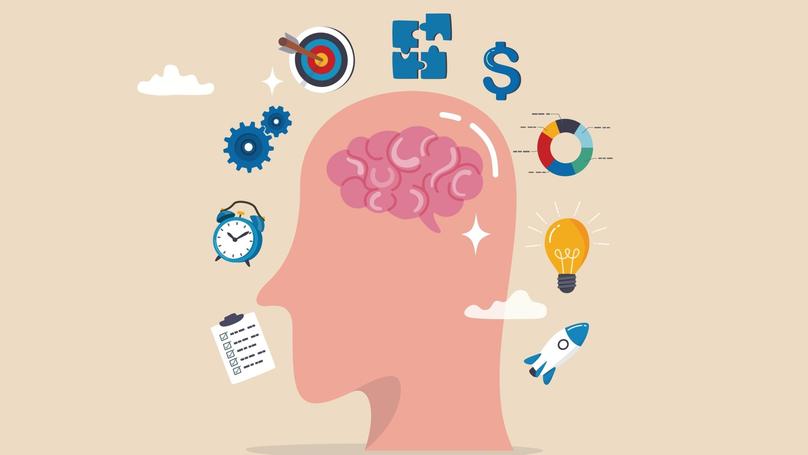
What is brainstorming
Brainstorming is a valuable tool for identifying problems discovering new solutions, generating ideas, and creating creative proposals. Interestingly, brainstorming is primarily a group brainstorming in order to generate and evaluate as many unique ideas, concepts, and suggestions as possible from every team member.
During the brainstorming process, all participants are encouraged to freely express their ideas, suggest bold and unexpected concepts, and share their thoughts on various topics. By the end of the meeting, the team collectively selects the most successful, fitting, and relevant suggestions, which can then be implemented and evaluated for effectiveness. Brainstorming can yield quick and tangible results, but only if you know the rules and techniques. We will discuss exactly that.
The origins and essence of brainstorming
The brainstorming method has been used for several decades, though it turns out it's even older than that. In the early 1940s, American marketer Alex Osborn, one of the founders of the advertising agency BBDO, now part of the largest global network headquartered in New York, described the brainstorming technique in his book "How to Think Up." Over the next ten years, the advertising director continued to refine his method, and in 1953, he published another work, "Applied Imagination: Principles and Procedures of Creative Problem Solving." In this second book, Osborn introduced a modified and significantly improved version of the brainstorming technique.
It was Osborn who formulated the key brainstorming rules, which are still used today:
-
No criticism - Avoid criticizing or logically evaluating your colleagues' ideas or even your own during brainstorming. Don't be quick to dismiss suggestions or write them off. There's a good chance they could prove helpful later on.
-
Quantity over quality - The brainstorming process revolves around continuously generating ideas. The more, the better. Osborn believed that the likelihood of finding the perfect solution increases as the number of potential ideas grows.
-
Prioritize the wildest ideas - According to Osborn, the most unconventional, strange, and seemingly crazy ideas are often the most successful and effective.
-
Refining ideas is just as important - Most suggestions need to be enhanced, modified, combined with others, or fine-tuned to develop a genuinely working idea.
Of course, time moves on, and Osborn's classic brainstorming method has evolved significantly since then. New supplementary rules and principles have been added to the technique. Today, large corporations and small businesses use brainstorming, adapting it to their specific goals, company culture, and the market as a whole. For instance, the American multinational corporation Google frequently relies on brainstorming to resolve challenges. They've introduced new principles that complement Osborn's original rules:
-
Target audience analysis. First and foremost, it's essential to understand your customers' habits, needs, desires, values, and life priorities. It is important to implement a solution that addresses real consumer problems and simplifies their lives.
-
Concise idea formulation. Before presenting your idea to colleagues, it's essential to sum it up in a single sentence of six or seven words. This ensures that you convey precisely the thought in mind and allows you to re-evaluate whether it's as promising as it first seemed or needs refinement.
-
Idea visualization. At Google, there's an emphasis on bringing the most creative ideas to life by creating prototypes for each. Testing a solution in practice before moving forward with large-scale production is crucial. Visualizing a concept allows you to clearly determine whether it works or not. Moreover, if the idea turns out to be flawed, this approach helps identify its shortcomings and figure out how to fix them.
Thus, any company can use the brainstorming method; it does not have to be a huge corporation with dozens of branches. Brainstorming is often applied at the startup level, during the development of first products or the launch of MVPs, to find the most effective and successful ways to bring ideas to life.
Why is brainstorming important for everyone?
As we've already established, brainstorming iis considered the most effective way to quickly come up with interesting and creative solutions to problems. It literally forces the human brain to work harder in the moment, rather than waiting for inspiration or a surge of creativity. This is why brainstorming is most commonly used in urgent situations, for example, when you must quickly develop a name or slogan for a new product.
In reality, brainstorming isn't just an effective tool for generating ideas but a powerful way to gather diverse opinions from the team, allowing everyone to express themselves and be heard. Additionally, brainstorming fosters team cohesion. It's especially beneficial for newcomers who may not know everyone yet, feel shy, or hesitate to participate in broader tasks. Brainstorming helps them engage comfortably and casually in the work environment, making them feel like part of the team. Often, the fresh perspective of newcomers leads to the generation of the most interesting and unexpected ideas.
Brainstorming also contributes to the development of critical and creative thinking. It helps participants learn how to thoroughly analyze situations, compare them, draw parallels, and propose original solutions. Brainstorming often answers key questions, such as how a company distinguishes itself from its competitors and its advantages.
How to Brainstorm: Key Stages
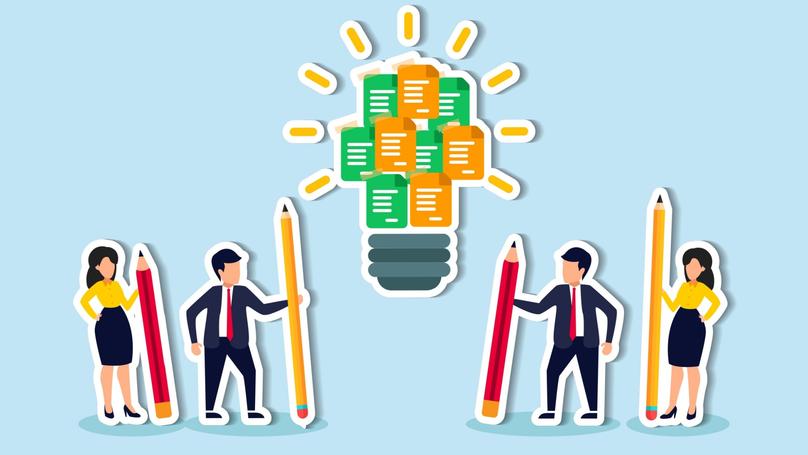
To ensure brainstorming is productive, it's essential to systematize the process and create an action plan. Typically, a meeting for brainstorming activities is divided into several stages:
Stage 1. Preparation
This stage involves selecting the team members who will participate in the brainstorming session, notifying them (ideally 2-3 days in advance), and choosing the location and time (e.g., in the conference room at 10:00). Additionally, it's crucial at this point to outline the topic of discussion, clearly define the problem the company is facing, and set the objectives that need to be addressed. This allows participants to focus on the goal, think about potential solutions, and formulate ideas.
Stage 2. Gathering of participants and introduction
Alex Osborn believed brainstorming works best with 5 to 10-12 participants. It's most effective to assemble a team of experts from different fields. Depending on the issue, the group might include a developer, designer, marketer, and economist. Alongside the participants, it's crucial to select a moderator for the brainstorming session to manage the process, ensure that key rules are followed, and summarize interim conclusions.
An equally important factor is a comfortable environment for the meeting. Ideally, there should be a round table so participants can see each other, exchange feedback, and engage in dialogue. Many leaders prefer to hold brainstorming sessions in a more informal setting, encouraging participants to relax in bean bags, bring coffee and snacks, and start the session with casual conversations about how their day or week has been.
Stage 3. Warm-up
Not all leaders begin brainstorming with a warm-up, so this step isn't mandatory. However, after gathering the participants, it's often beneficial to have a warm-up to help everyone relax, shift gears, create a comfortable psychological atmosphere, and get into a work mindset. A simple warm-up game could involve word associations, where participants take turns naming their associations with the theme of the upcoming brainstorming session. This helps stimulate creative thinking.
Stage 4. Defining the task
It's essential to ensure that each participant clearly understands what they'll be working on. The goal must be formulated precisely and unambiguously, leaving no room for misinterpretation. For example, the task for a brainstorming session might be phrased like this:
-
"How can we increase website conversion?"
-
"How can we encourage customers to return and make repeat purchases?"
-
"How do we adapt our product to the international market?"
-
"What processes in a company can be automated to reduce costs?"
-
"What unmet needs do consumers in our niche have?" and so on.
In other words, the request must be as specific as the answer you want to receive.
Stage 5. Generating ideas
Participants must take turns expressing their assumptions and options for solving the problem. It's best to write down ideas that come to mind. The most effective way to use a board to highlight the most promising and interesting proposals is particularly effective. Remember, the success of the brainstorming session largely depends on the moderator, so it's important for them to:
-
Prevent any form of criticism and remind the group of the main rule of brainstorming-the value of all ideas;
-
Ask additional questions and help develop promising ideas;
-
Keep track of time;
-
Encourage discussions of the proposed ideas and keep the conversation lively;
-
Foster a friendly and comfortable atmosphere.
Typically, the idea generation phase lasts around 30-40 minutes. This is usually enough time to gather key ideas and suggest even the riskiest suggestions.
Stage 5. Analyzing ideas and selecting the best ones
After the brainstorming session, the team needs to sift through the entire list of ideas and select the most relevant to the task. Participants then discuss each idea, share their opinions, provide arguments, and reach a verdict. Similar suggestions are often combined, some ideas are refined, and most are discarded. At this stage, the initial principle of "quantity over quality" shifts to the opposite, and the brainstorming session concludes with only the most promising ideas remaining.
Brainstorming techniques

During the idea generation stage, various techniques are used to keep participants from getting stuck and to encourage them to produce as many suggestions as possible. Let's explore some of the most common and effective brainstorming techniques:
-
"6 - 3 - 5" or Silent Brainstorming Method
This technique was invented by German business consultant Bernd Rohrbach. The idea is that six people (ideally, though the group can be larger) each come up with and write down three ideas on a card within five minutes. Afterward, all participants exchanged cards and built on the ideas of their colleagues, coming up with three more suggestions. This cycle can be repeated several times, after which participants discuss their generated proposals. This method is considered fair, as every participant contributes the same number of ideas, ensuring equal input to the collective effort.
-
The "Stepladder" Method
This interesting method works as follows: the task is presented to all participants, but then everyone except two group members leaves the room (conference room, office, or other space). The two remaining participants discuss ideas with each other for the next 3-5 minutes. Then, one more person joins them, and the discussion continues with the trio. Every 5 minutes, another person joins until the whole team is involved in the conversation. This method works best with no more than 5 participants, as a larger group may make the meeting too long, and some employees might lose interest while waiting for their turn. Despite the potential wait times, the "Stepladder" method is effective because each time a new team member joins the discussion, it offers a fresh perspective, shifting the view of the situation and revealing insights that may have been missed earlier.
-
The Eidetic Image Method
This method was developed by psychologist Jacqueline Sussman. It involves using one's personal life experiences and stored subconscious impressions during the brainstorming process. Depending on the brainstorming goal, participants recall what designs they've seen for similar products, what solutions have been previously applied to similar problems, how they acted in the past, or even how their favorite TV show characters responded to such situations. Building on this existing knowledge, participants start generating new ideas from a foundation of previous experiences. This strategy is beneficial when aiming to improve a product, modify it, or conduct a rebranding effort.
-
The Six Thinking Hats Method
This unique methodology was developed by British psychologist Edward de Bono, who believed that issues with idea generation and creative thinking stem from people being accustomed to perceiving reality, events, and challenges from the same point of view without trying to shift their perspective.
De Bono compared this to a person always wearing the same hat-for instance, the hat of a pessimist, hypochondriac, optimist, or suspicious person. He says his method helps break free from stereotypical and habitual thinking. He proposed the following: each brainstorming participant metaphorically wears a different colored hat.
For example, a person wearing a white hat is responsible for facts, objectivity, and impartiality. The red hat focuses on emotions and feelings. The black hat wearer evaluates and criticizes other participants' ideas. The yellow hat wearer, on the other hand, sees only the benefits and positive aspects of any idea. The green hat is worn by the most creative participant, who puts forward bold and wild ideas. Finally, the participant in the blue hat joins at the end of the brainstorming session to summarize, analyze, and synthesize everything that has been said.
This method allows participants to look at the same situation from all possible angles, generating a wide variety of ideas that are different from one another and reaching unexpected conclusions.
-
Starbusting
And this method, unlike all the previous ones, is best used when several key ideas have already been formulated and need to be explored in greater detail. The starbursting technique involves drawing a star with the core idea at its center, which needs to be evaluated. Six fundamental questions branch out from this central idea, forming a six-pointed star. These fundamental questions are:
-
What? (This requires a detailed and thorough description and analysis of the idea.)
-
Who? (What human resources are needed to implement the idea, and who is the target audience for this product or service?)
-
How? (How and with what tools can the idea be brought to life, and how can you attract the audience's interest in this product?)
-
When? (Precise timing-how long might the process of realizing this idea take?)
-
Where? (The space or environment needed for implementation and any additional resources required)
-
Why? (The final question, summing up all the others-why is this idea the most promising, and why should the target audience care about this product or service?)
This method allows for the most comprehensive analysis of an idea from various perspectives.
-
Reverse brainstorming
This strategy often identifies and eliminates flaws in an already-developed product. In this case, brainstorming participants generate ideas and propose hypotheses focused on a particular product's weaknesses, imperfections, and shortcomings. The goal is to concentrate on identifying these issues and finding solutions for each one.
Questions for reverse brainstorming might sound like this:
-
"What kind of customer service would ensure clients never return for repeat purchases?"
-
"What should we do to make our application difficult and inconvenient for users?" and other such questions.
While these questions may seem absurd, their answers can help you avoid many mistakes and uncover aspects previously unnoticed by the team but are frustrating for consumers. In this approach, brainstorming participants put themselves in customers' shoes, trying to understand what complicates their experience and how to make it easier. This method is typically used when other brainstorming techniques have proven ineffective or unsuitable.
By the way, to evaluate the resulting ideas, you can also use several brainstorming methods:
-
Anonymous voting, when each participant writes down their favorite idea on a card or piece of paper. The idea with the most votes is selected for implementation.
-
Scoring system, which involves open evaluation, that is, assigning points to each idea (it is best to use a five-point scale);
-
FAN is the most comprehensive and well-rounded evaluation method. It assesses an idea based on three key characteristics (F-feasible, A-attractive, N-novel).
It's essential to remember that the analysis and final selection of an idea are not as much a creative process as a logical one. You must carefully weigh all assumptions and arguments "for" and "against" before settling on the most appropriate solution. Only by doing so can brainstorming deliver quick and high-quality results.
Example of using brainstorming
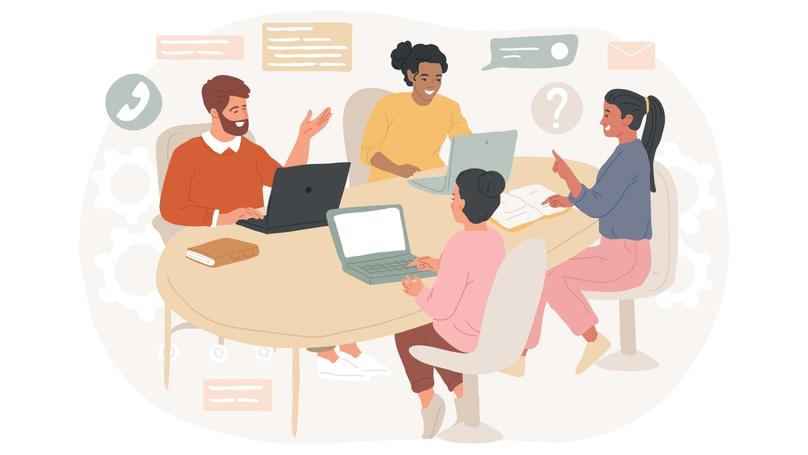
Let's imagine that one department in a large company is experiencing low customer satisfaction. The manager gathers a team for a brainstorming session to address this challenge.
Let's combine the first and second stages - preparation and gathering of participants. First, define a clear goal for the brainstorming activities. In this case, it could be: "How can we increase customer satisfaction?" or "Find new solutions and ideas to improve customer service."
Next, select the date and location. If your office has a conference room or meeting space with round tables and large windows, this could be an ideal environment for the meeting. It's also important to schedule the time-perhaps 5:00 PM at the end of the workday, or better yet, at 10:00 AM. It's a good idea to ask participants what works best for them. Remember to include a diverse group of specialists. If the problem concerns customer dissatisfaction, inviting customer service employees, product developers, designers, and technical support specialists is wise. Additionally, appoint one participant to act as the moderator. Inform everyone well in advance so they can prepare and start thinking about potential ideas.
On the day of the brainstorming activities, welcome all participants and remind them of the topic to be discussed. Start with a warm-up to lighten the atmosphere and prepare everyone for idea generation. Once the team feels ready, move on to the main stage. The facilitator or moderator can ask guiding questions to help resolve the issue of low customer satisfaction, such as:
-
"What problems are our customers facing that our product doesn't solve?";
-
"What are customers saying in reviews, comments, and surveys? What are they most dissatisfied with?";
-
"How can we improve their experience?";
-
"How can we enhance service quality in both physical stores and online?";
-
"What features or capabilities could we add to increase satisfaction?";
-
"Does the price of our product match its value?"
Some ideas or suggestions might include:
-
"Introducing aт online feature for instant customer support";
-
"Regular customer surveys after purchases to gather feedback";
-
"Developing a loyalty program";
-
"Encouraging user-generated content."
Testing and tracking progress can begin if several ideas seem feasible and promising. Specific metrics should be established to ensure accurate results, such as reducing wait times in support chat, receiving more positive reviews, and decreasing negative comments. In other words, team members must leave the brainstorming meeting with a clear understanding of the actions they need to take to improve customer service.
Brainstorming software
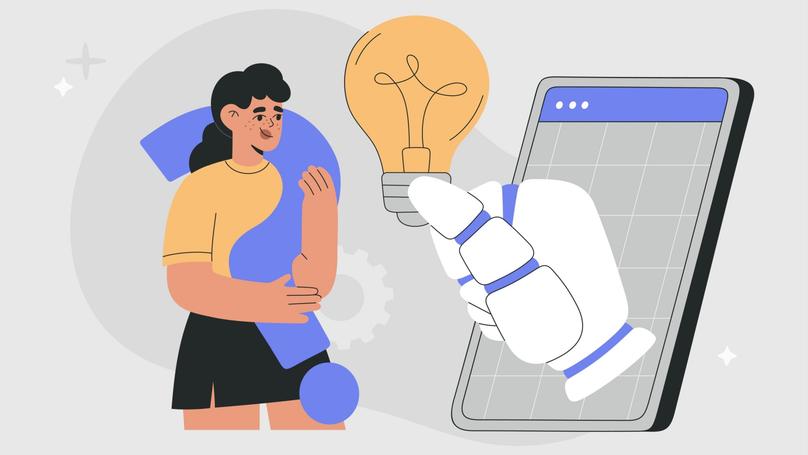
In order to brainstorm online, contribute, edit and supplement ideas in real time, track their implementation, and monitor progress, it is most effective to use additional digital tools. Among them are the following programs:
-
AhaSlides
This is a special service for creating interactive presentations and other documents using polls, word clouds, open-ended questions and other game features. Typically this application is used not only for brainstorming activities but also to collect opinions from the audience in real time, increase activity during a lecture or master class, conduct quizzes, collect questions and feedback. For this purpose in AhaSlides there are many (several hundred!) ready-made templates that can be modified to fit your needs.
A free version is available for small teams of up to 15 people, while Extended versions of AhaSlides for more users cost $8, $11, and $16 per month.
-
Miro
Interactive virtual board Miro has long been popular for solving various problems related to data systematization and visual presentation. It greatly simplifies collaboration on various projects, product development, and rebranding.
Miro is used to store information, share data, and visualize it, all of which can be done by teams of 30, 50, or more people at the same time. The advantage of online boards is that they are infinite. They allow users to add new information without deleting earlier content, making them an excellent tool for brainstorming-they will undoubtedly accommodate all your proposed ideas.
This service has several subscription options. Interestingly, the free plan includes a workspace with three editable boards simultaneously. This is more than enough if Miro is used within a small company. Paid subscriptions with unlimited boards start at $8 per month.
-
Bubbl.us
This is a simple and intuitive service for creating all kinds of chart, diagram, and graphs, in addition to exporting them to various formats. In addition, Bubbl.us provides real-time collaboration, change logging, editing for everyone with a link, adding images and other files, user management, and many more features. The application allows you to brainstorm or join it as a participant from literally any device - phone, tablet, laptop - and present your ideas clearly in the form of entire presentations or concise sketchy sketches.
The service offers a free trial version that can be used for 30 days to familiarize users with the variety of functions and ensure the simplicity of Bubbl.us's functionality. A premium subscription costs almost $5 per month and includes an unlimited number of created work cards, additional templates, and help generating ideas from artificial intelligence.
-
LucidChart
This is another powerful tool for creating flowcharts, diagrams, and other data systematization. This program has many templates that you can use to make things easier. On the other hand, users often create their forms and sheets for work, adjusting them to their habits and needs. LucidChart is also integrated with Confluence and JIRA services, allowing you to quickly import content from other sources such as YouTube, Dropbox, and Facebook into your workspace. LucidChart also actively uses AI, which helps organize information, plan and draw up technical charts, and format them. To find out prices for the service, LucidChart suggests registering on the official website and choosing the most beneficial option for cooperation.
- Wisemapping
This service has a simple and intuitive interface that allows you to draw various maps, diagrams, and charts, as well as form mind maps. Like other platforms, Wisemapping supports the import and export of data in standard formats such as JPEG, PNG, PDF, SVG, and other less common formats. It allows you to engage in a joint activity, design your workspace in a style you and your team like, create unique templates, or use ready-made ones.
Interestingly, Wisemapping is a service that runs on open-source software. Anyone can easily access it free of charge to change, customize, and use the code at their discretion. This is because software with such code is developed and decentralized by many unrelated developers. Its advantages are transparency, reliability, and flexibility.
Advantages and disadvantages of brainstorming
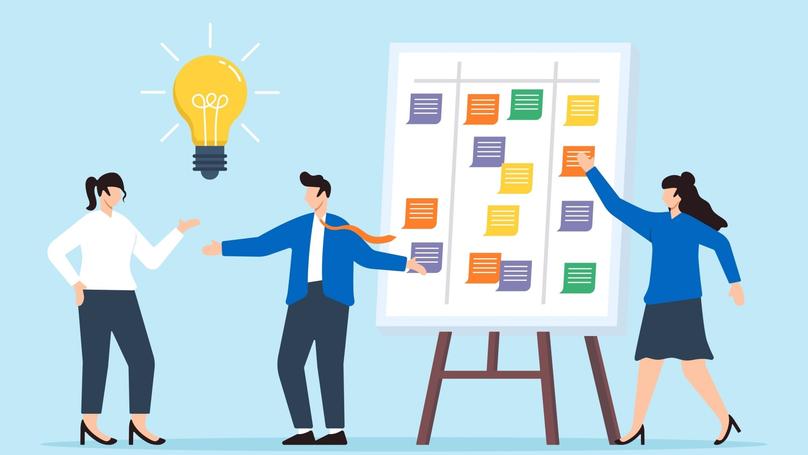
Creative professionals, such as writers and screenwriters, designers, and developers, consider brainstorming the most suitable and widespread method of brainstorming. However, brainstorming can be used in a variety of areas - from finance to medicine. Additionally, brainstorming has the following major advantages in addition to versatility:
-
efficiency and the ability to find a quick way out of ends situations, creative stagnation, and crises;
-
high efficiency;
-
developing collective thinking and promoting team cohesion;
-
quick adaptation of new employees;
-
developing the creative skills of specialists and unlocking their creative potential;
-
increasing their motivation and interest;
-
the opportunity to take a multifaceted view of the problem and obtain all sorts of alternative options her solutions;
-
ease and accessibility of use, and the absence of additional financial and other costs.
However, brainstorming also has disadvantages. Among them:
-
Overwhelming idea generation may lead to a loss of focus;
-
Risk of chaos and disorganization;
-
Unpredictable results;
-
Not all proposed ideas are workable;
-
Difficulties with concentration due to a constant stream of thoughts.
Conclusion
There are strengths and weaknesses to brainstorming. It can help you solve problems when you need to quickly find a way out of a critical situation. However, brainstorming just for the sake of brainstorming is not worth it. Setting goals and objectives and gathering participants require time and resources for careful planning.
Overusing brainstorming can disrupt core work processes, so it should only be employed for its intended purpose. It's better to prioritize brainstorming sessions properly and avoid common mistakes like vague task definitions, allowing criticism, or rushing decisions. Follow the brainstorming rules and practice various methods for different purposes, but remember that everything should be in moderation. Each brainstorming session will unite your team, bring new creative ideas, allow you to remain flexible and mobile, and help your employees stay engaged and motivated.























